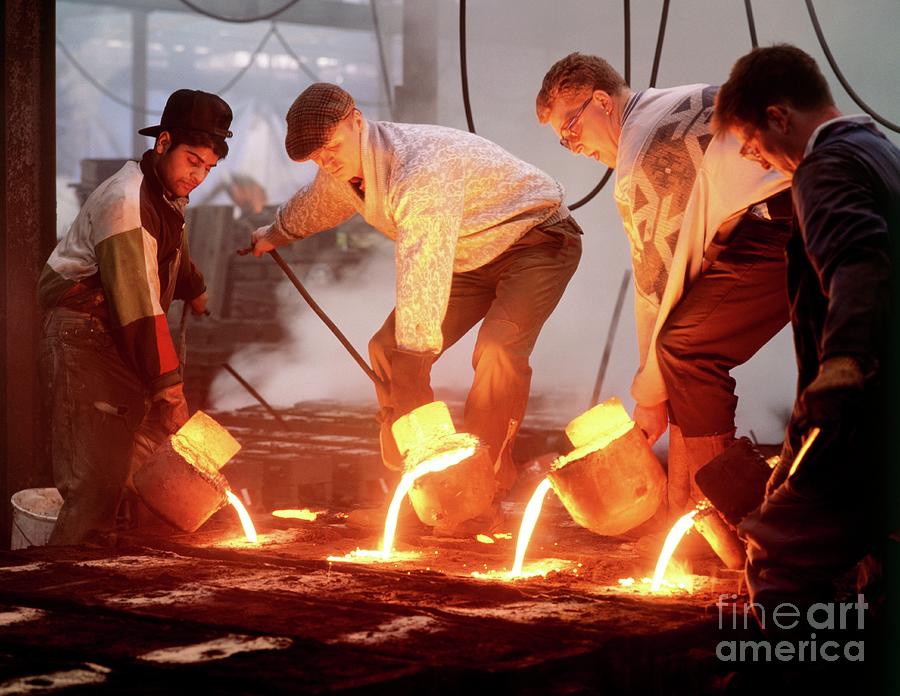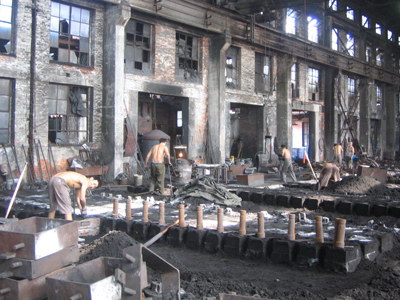Green initiatives in today’s Aluminum Foundry operations
Discover the Ingenious Methods Made Use Of in a Metal Foundry for Superior Casting Results
In today's affordable manufacturing landscape, metal foundries are increasingly taking on innovative techniques to enhance spreading outcomes - Aluminum Foundry. Advanced computer simulations enable accurate modeling of molten metal habits, while 3D printing enables fast manufacturing of complicated molds. In addition, environment-friendly products and automation improve procedures. These developments guarantee considerable improvements in effectiveness and top quality control. The impact of these innovations on sustainability and production practices stays to be completely discovered.
Advanced Computer System Simulations in Metal Casting
Advanced computer simulations have actually reinvented the metal casting process by enhancing precision and effectiveness. These sophisticated devices allow designers to produce digital models of actors parts, allowing them to examine and anticipate the behavior of liquified metal throughout the spreading stage. By simulating various parameters such as temperature level, flow rate, and air conditioning prices, manufacturers can determine prospective flaws prior to physical manufacturing begins.
This aggressive approach decreases waste and decreases pricey errors, ultimately bring about improved product high quality. In addition, simulations facilitate the optimization of mold and mildew styles, making certain that they meet the certain needs of each task. The combination of computational liquid dynamics (CFD) and limited element evaluation (FEA) additional adds to the precision of these simulations, providing insights that were formerly unattainable. Because of this, advanced computer simulations have actually ended up being an indispensable element of modern metal foundries, substantially progressing the industry's capacities.
3D Printing for Molds and Patterns
3D printing has actually become a groundbreaking strategy for creating molds and patterns in the metal foundry industry. This technology enables the rapid production of complex geometries that typical production approaches battle to achieve. By utilizing additive production, foundries can create detailed styles with minimized preparations and material waste. The ability to generate molds as needed permits for better flexibility in design versions, promoting faster prototyping and modifications.
In addition, 3D printing can make use of a variety of materials, consisting of steels and plastics, tailored to specific casting requirements. This flexibility improves the precision of molds, causing exceptional spreading end results with enhanced surface area coatings. In addition, the reduction in the variety of components called for streamlines assembly processes, better optimizing production effectiveness. As foundries remain to embrace 3D printing, they are poised to redefine sector standards, leading the way for innovation and improved efficiency in metal casting operations.
Eco-Friendly Materials and Processes
As the metal foundry industry faces increasing stress to lower its ecological impact, the adoption of green products and processes has actually ended up being essential. Foundries are currently checking out sustainable alternatives to traditional materials, such as using recycled steels and bio-based binders. These materials not only decrease waste but also reduced energy consumption throughout manufacturing.
In addition, developments in sand casting techniques have actually caused using synthetic sands that are much less harmful to the atmosphere. Shops are also executing cutting-edge procedures like molten metal therapy that minimizes emissions and boosts the high quality of cast products.
Water-based finishings have actually replaced toxic solvents, advertising a more secure work atmosphere. By integrating these eco-friendly techniques, metal foundries can noticeably reduce their eco-friendly impact while preserving high-quality casting results. This change not just benefits the atmosphere yet also lines up with the growing consumer need for lasting manufacturing services
Automation and Robotics in Foundry Procedures
While the metal foundry sector welcomes technology, the integration of automation and robotics go to this site is changing procedures significantly. Automated systems enhance procedures such as mold and mildew production, metal pouring, and casting completing, substantially improving effectiveness. Robotics promote the handling of hefty products, reducing the risk of office injuries and guaranteeing much safer atmospheres.

Better, using automated assisted cars (AGVs) enhances material transport within centers, guaranteeing prompt distribution of elements to ideal workstations. By implementing these innovations, foundries can adapt to changing demands with better agility, ultimately bring about enhanced profitability and competition out there. As automation and robotics continue to evolve, they hold the potential to redefine standard foundry techniques and drive more advancements in casting techniques.
Real-Time Monitoring and Quality Assurance Techniques
The improvements in automation and robotics have led the way for a lot more innovative techniques to quality assurance in metal foundries. Real-time tracking systems utilize sophisticated sensors and data analytics to track important specifications throughout the casting procedure. These systems continually analyze variables such as pressure, temperature, and material composition, allowing prompt detection of discrepancies from developed standards.
Quality control methods currently include artificial intelligence formulas that analyze historical data to anticipate prospective flaws prior to they happen. This positive technique decreases waste and boosts total manufacturing effectiveness. Additionally, incorporated feedback loops enable for fast changes, guaranteeing that each casting satisfies rigid high quality demands.
The application of electronic doubles-- online replicas of physical properties-- has likewise reinvented high quality guarantee, enabling engineers to imitate and optimize procedures in real-time. Together, these ingenious methods greatly improve the integrity and quality of castings, establishing new market criteria in metal foundry procedures.
Frequently Asked Inquiries
What Sorts of Metals Are Frequently Cast in Shops?
Typically cast steels in foundries her response include light weight aluminum, iron, brass, and bronze. Each metal exhibits one-of-a-kind buildings, making them appropriate for different applications, such as automobile components, equipment, and artistic sculptures, boosting their flexibility in production.

For how long Does the Casting Process Commonly Take?
The casting process normally takes several hours to days, depending upon variables such as the intricacy of the mold, kind of metal made use of, and air conditioning needs. Each phase affects the overall period markedly.
What Safety Steps Are in Area for Foundry Employees?

Just how Are Flaws in Castings Identified and Addressed?
Defects in castings are determined via visual assessments and non-destructive screening approaches. As soon as found, foundry workers address them by improving procedures, changing material make-ups, and applying rehabilitative actions to assure top quality and compliance with requirements.
What Is the Expense Array for Metal Casting Services?
The expense array for metal casting services typically ranges $1 to $10 per pound, depending on variables such as product kind, complexity of the layout, and manufacturing quantity, influencing total pricing substantially.
In today's affordable manufacturing landscape, metal foundries are increasingly taking on ingenious methods to boost spreading outcomes. As the metal foundry industry deals with enhancing stress to decrease its environmental footprint, the fostering of you could try these out environment-friendly products and processes has become necessary. Foundries are currently exploring lasting choices to conventional products, such as making use of recycled steels and bio-based binders. By integrating these environmentally friendly methods, metal foundries can considerably lower their environmental influence while keeping high-quality spreading outcomes. The advancements in automation and robotics have actually led the means for more innovative techniques to high quality guarantee in metal foundries.